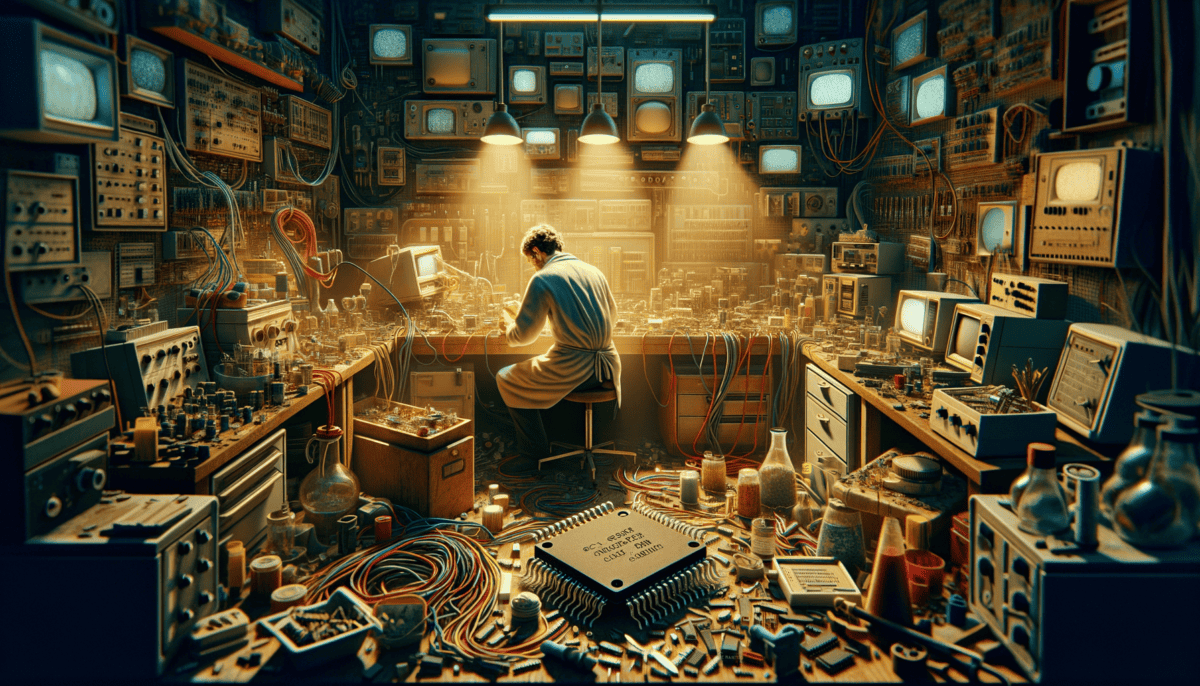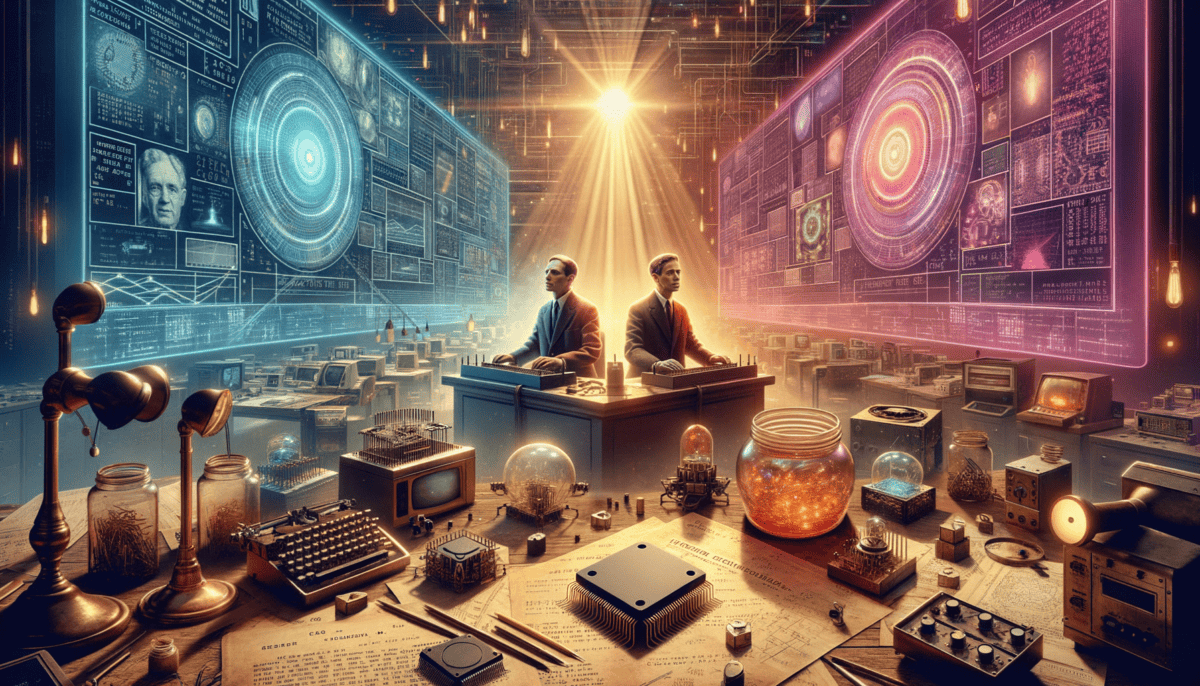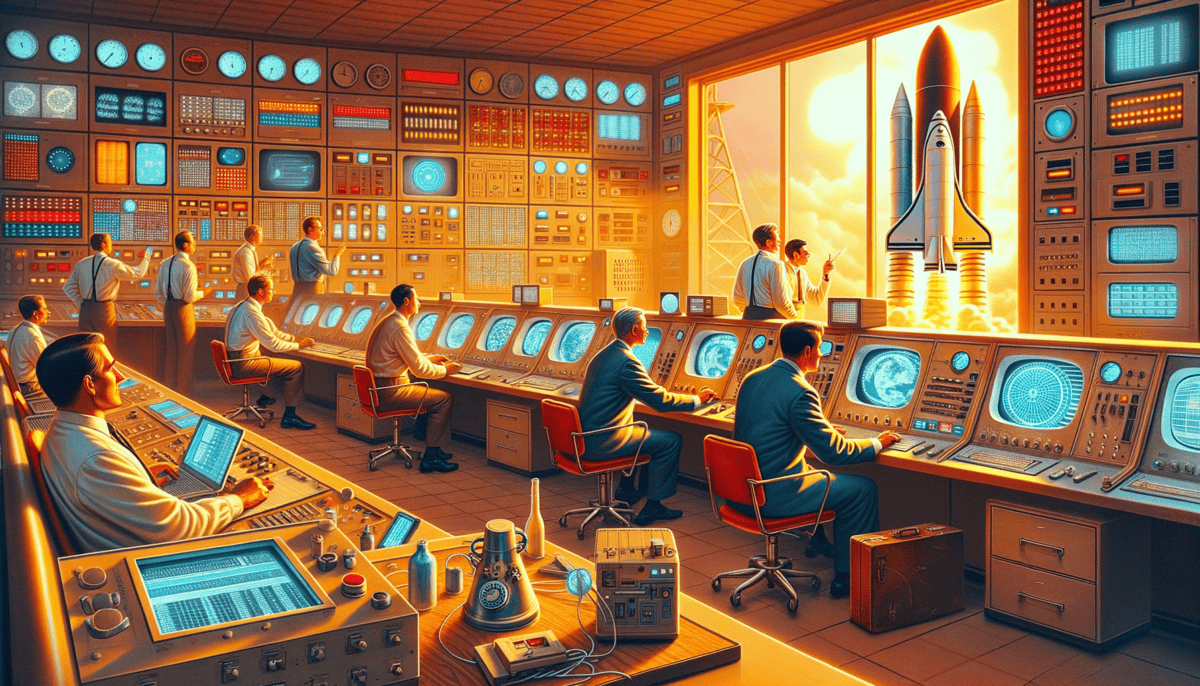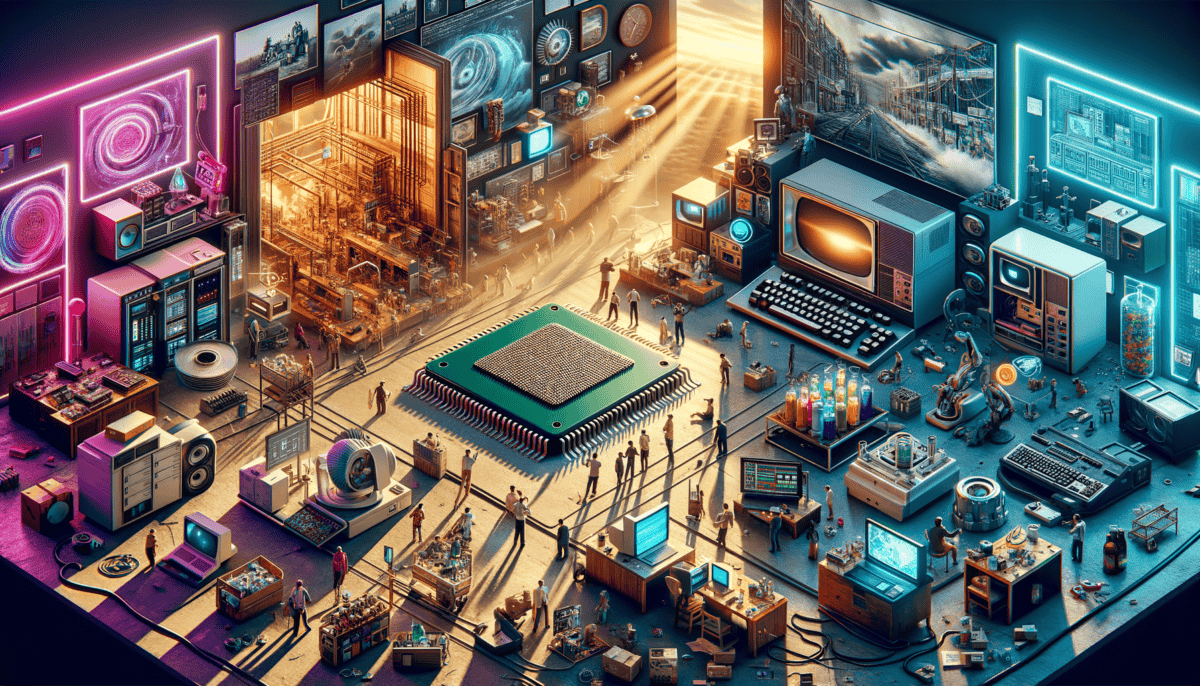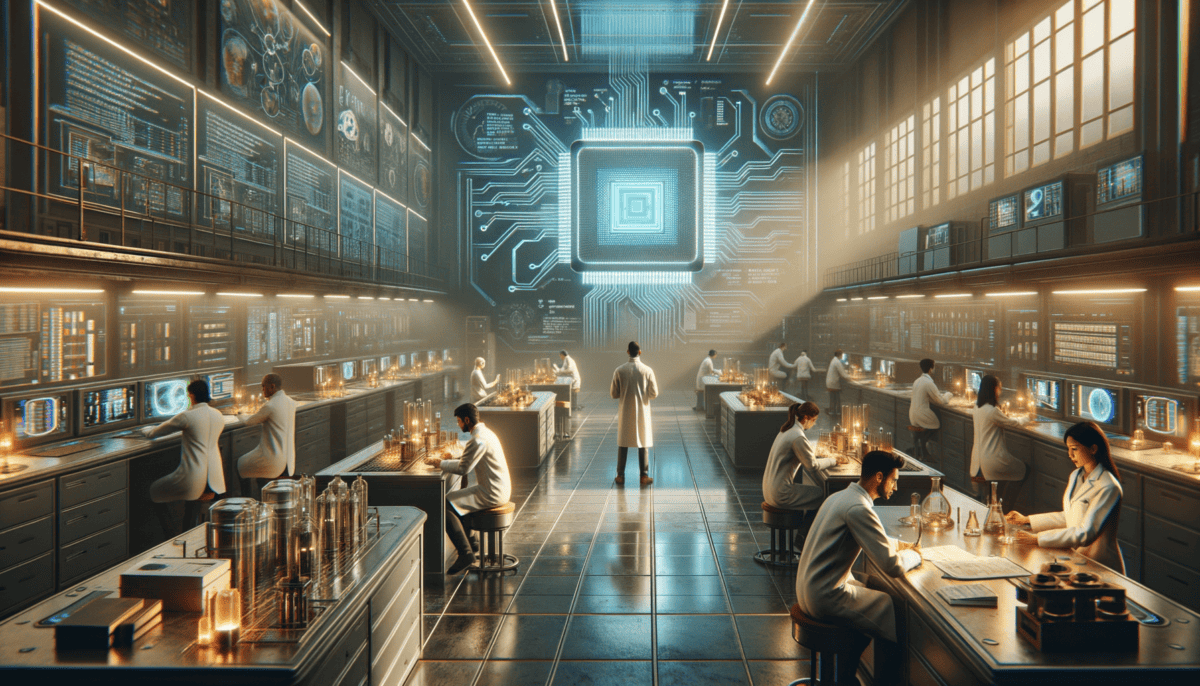The Curious Minds
Once upon a time, in a world without smartphones or tablets, two brilliant boys named Jack and Bob loved to take things apart. They were curious about how everything worked!
Jack Kilby lived in Great Bend, Kansas. He spent hours in his dad’s radio shop, playing with wires and batteries. One day, his dad found him surrounded by radio parts.
“What are you doing, Jack?” his father asked with a smile.
“I want to know how radios work!” Jack replied, his eyes shining with excitement.
Meanwhile, in California, young Robert Noyce (everyone called him Bob) was just as curious. He built a small airplane in his backyard when he was just a kid!
“Mom! Dad! Come look what I made!” Bob shouted one day.
His parents rushed outside to see their son’s latest invention. “Oh my!” his mother gasped. “You’re going to be a great scientist someday!”
Both boys grew up in a time when technology was very different from today:
- TVs were big boxes with tiny screens
- Phones were connected to walls with wires
- ️ Computers filled entire rooms
- Radios used large glass tubes to work
As Jack and Bob grew older, they went to different schools but shared the same dream: to make machines smaller and better. They studied hard in science class and learned about electricity.
In college, both men learned about a big problem. Computers needed too many parts to work. The parts were big and often broke down. Something had to change!
Bob worked at a place called Fairchild in California. Jack got a job at Texas Instruments in Dallas. They didn’t know each other yet, but both were thinking about the same problem.
Every night, Jack would sit at his desk, drawing pictures of new ways to make computer parts. Bob did the same thing in his laboratory. They were like explorers, but instead of searching for new lands, they were looking for new ways to make technology better.
“What if we could put all these parts together in one tiny piece?” Jack wondered out loud one evening.
Little did they know, their curious minds were about to spark a revolution that would change how we live, work, and play. Their amazing ideas would help create the tiny computer chips that power our phones, tablets, and games today!
The stage was set for one of the biggest discoveries in history. Jack and Bob were ready to solve the puzzle that would make computers smaller than anyone had ever imagined.
The First Spark
In the hot summer of 1958, Jack Kilby sat alone in his lab at Texas Instruments. Most people were on vacation, but Jack had a big idea he couldn’t wait to try.
“The problem is too many parts,” Jack said to himself, looking at the mess of wires on his desk. “We need to make them work together!”
Jack drew pictures in his notebook day after day. He wanted to put many parts on one tiny piece of material. People thought it was impossible, but Jack didn’t give up.
One hot afternoon, Jack jumped up from his chair. “I’ve got it!” he shouted. He had found a way to make all the parts from the same material – something called germanium.
His boss, Willis Adcock, came to see what Jack was so excited about.
“Show me what you’ve made, Jack,” Willis said.
Here’s what made Jack’s invention so special:
- It was very small
- ⚡ It used less power
- It had fewer parts that could break
- It worked better than old parts
On September 12, 1958, Jack showed his tiny circuit to everyone at Texas Instruments. He connected it to simple machine he built. When he pressed a button, the machine made a sound!
“Beep… beep… beep!” went the machine.
The room was silent. Then everyone started clapping! They knew they had just seen something amazing.
But Jack’s invention had some problems. It was hard to make, and some parts didn’t stick together well. The chip needed to be better before it could be used in real computers.
Meanwhile, in California, Bob Noyce was working on his own ideas. He thought silicon might work better than germanium. Bob didn’t know about Jack’s invention yet, but he was getting close to his own breakthrough.
“There must be a way to make these parts stick together better,” Bob told his team at Fairchild. He spent hours in his lab, trying new ways to connect tiny parts.
The race to make better computer chips had begun. Scientists and engineers around the world got excited about making things smaller and more powerful.
Jack’s invention was just the beginning. The tiny chip he made would lead to bigger and better things. Soon, Bob Noyce would make his own amazing discovery, and together their ideas would start a technology revolution!
Racing Against Limits
While Jack Kilby showed off his new chip in Texas, Bob Noyce was busy in sunny California. He had a different idea about how to make tiny computer parts.
“Silicon is the answer!” Bob told his team at Fairchild. “It’s like sand, but it can do amazing things!”
One morning, Bob rushed into the lab with exciting news.
“I know how to make the parts stick together better!” he said, drawing his idea on the whiteboard. His way used tiny metal paths to connect everything.
Meanwhile, Jack was still working hard in Texas. When he heard about Bob’s work, he knew they had to work faster.
Soon, both men had special papers called patents for their ideas. But instead of fighting, something wonderful happened!
Here’s what made their inventions special together:
- Jack’s chip could do lots of jobs at once
- Bob’s chip was easier to make
- Together, they worked better than alone
- They changed how we make technology
More scientists came to work in Silicon Valley. They built big buildings called labs where they could make chips better and faster.
“Every year, we can make chips twice as powerful!” Bob told his friends. He was right! The chips got smaller and better very quickly.
Companies started using these tiny chips in new ways. They made:
• Better calculators
• Smaller radios
• Faster computers
• Space rockets!
One day, a young engineer named Gordon Moore made a special guess. He said chips would keep getting better and better, twice as good every two years!
“That’s impossible!” some people said. But Gordon was right! His idea became so famous that people called it “Moore’s Law.”
Jack and Bob’s race to make better chips helped everyone. Their ideas spread all over the world, and more people started making new kinds of chips.
“Sometimes the best races aren’t about winning,” Bob said years later. “They’re about making something wonderful together.”
The friendly competition between Jack and Bob helped make computers smaller and better. Their hard work was just the beginning of an amazing journey in technology!
As more people learned about making chips, they started thinking about new ways to use them. Some wanted to send them to space, while others dreamed of putting them in homes. The adventure was just getting started!
From Laboratory to World
The tiny chips that Jack and Bob made were ready for big adventures! NASA, the space people, got very excited about these small wonders.
“These chips are perfect for our rockets!” said a NASA scientist. “They’re small, light, and super smart!”
Sally, a young NASA engineer, held up a chip. “Look how tiny it is! But it can do the work of hundreds of old parts!”
The military loved the chips too. They made:
- Better radios for soldiers
- Smarter flying machines
- Faster computers for planning
- Safer helicopters
People started using chips in new ways every day. Tom, a phone maker, jumped with joy.
“We can make phones smaller now!” he said. “No more big, heavy phones on the wall!”
In schools, teachers got excited about new learning tools. “Look what these chips can do!” said Ms. Brown, showing her class a calculator.
Doctors found ways to use chips to help sick people. They made:
• Better heart monitors
• Smart medicine helpers
• X-ray machines
• Tiny hearing aids
Around the world, people started making chips in new places. Japan built huge chip factories. Germany made special tools with chips.
“The whole world is changing!” said Maria, who worked in a chip factory. “These tiny things are everywhere!”
Every day, someone found a new way to use chips. They made cars safer, toys more fun, and work easier.
But the biggest change was coming soon – personal computers! People started dreaming about having their own computers at home.
“Just wait,” said Bob Noyce with a smile. “These chips will change how we live, work, and play!”
Young inventors looked at these chips with big dreams. “What else can we make?” they wondered. The answer was: almost anything!
Companies started growing bigger and bigger. They needed more people to make chips and think of new ways to use them. The tiny chip revolution was getting bigger every day!
The Silicon Revolution Spreads
The tiny chips were about to make something amazing – home computers! ️ A young man named Steve walked into his garage with a big dream.
“We can make computers that everyone can use!” Steve told his friend Steve. Yes, both friends were named Steve! They started a company called Apple.
Another company called Intel was making better and better chips. Gordon Moore, who helped start Intel, had a special idea.
“Our chips will get twice as smart every two years!” Gordon said. People called this “Moore’s Law,” and he was right!
Computers started showing up everywhere:
- Schools got computer labs
- Offices got faster
- Kids got video games
- Phones got smarter
In Japan, a boy named Aki got his first computer. “Now I can write stories and draw pictures!” he said with joy.
Companies all over the world joined the chip race. They built big factories called “fabs” where special robots helped make chips.
“Look how clean we have to be!” said Maria, showing visitors the fab. Everyone wore special white suits to keep the chips safe.
The chips got so small that millions of tiny parts could fit on one chip smaller than your fingernail!
Kids started learning about computers in school. “When I grow up, I want to make games!” said Tommy, playing on his first computer.
• Help cars drive themselves
• Let us talk to friends far away
• Make movies with special effects
• Help doctors see inside bodies
The internet started connecting computers all over the world. “Now we can share ideas with everyone!” said Lisa, a teacher.
People started carrying tiny computers in their pockets – smartphones! “It’s like having a super-smart helper always with you,” said Miguel.
Old computer museums opened to show kids how far we’ve come. “Wow, computers used to be as big as a room!” said Jenny on a school trip.
The silicon revolution changed how we live, work, and play. And it all started with two curious minds who wanted to make things better!
Future Horizons
Today’s computer chips are super tiny and super smart! Dr. Lisa Chen walks into her lab with a big smile.
“We’re making chips that can think like people!” she says, showing her new quantum computer. It looks like a shiny silver box with rainbow lights. ✨
Young inventors are finding new ways to use chips:
- Robots that help clean the ocean
- Smart gardens that water themselves
- Tiny doctors that swim in your body
- Art that creates itself
“I want to make chips that help save the Earth!” says Maya, a 10-year-old student building her first robot.
Scientists are working hard to make chips better for our planet. “We’re using recycled materials and less power,” explains Dr. Chen.
In a classroom in Brazil, kids use special glasses to see things that aren’t really there. “It’s like magic!” laughs Carlos. “I can see dinosaurs walking around!”
Companies are making chips that can fix themselves when they break. “Just like how your body heals a cut,” explains Engineer Sarah.
Some chips are so small they could fit inside a grain of sand! But they’re super powerful!
In Japan, robots with special chips help take care of older people. “The robots are like friendly helpers,” says Grandmother Yuki with a smile.
All around the world, kids like you are dreaming up new ways to use chips. “Maybe I’ll make a chip that helps us talk to animals!” says Joey.
The story of computer chips shows us that big dreams can come true. It started with Jack Kilby and Robert Noyce thinking differently. Now it’s your turn! What will you create?
From tiny beginnings in a quiet lab to changing the whole world, computer chips show us that anything is possible. The future is waiting for your ideas!
What amazing things will computer chips do next? That’s up to dreamers like you!


